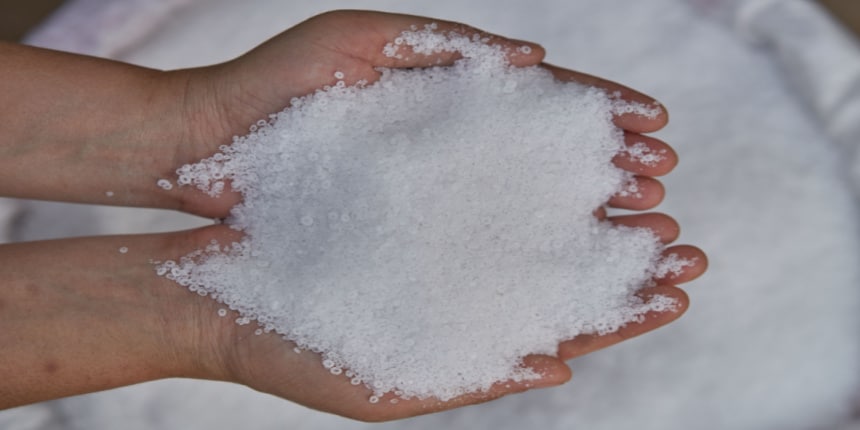NH4+ Full Form
What is the full form of NH4?
The full form of NH4 is Ammonium Ion. NH4+ is a colourless cation and gives colourless salts with colourless anions. NH4+ is present in an acidic medium only. How can an ion formed from the conjugate base of the coloured compound be colourless? In this article, we will find the answers to such questions. We will be knowing about NH4+ more in detail.
- What is the full form of NH4?
- Formation of Ammonium Ions,
- Structure and Bonding
- Properties of Ammonium Ion
- Ammonium Salts
- Applications of Ammonium
- How are Ammonium Ions Detected?

Formation of Ammonium Ions,
An ammonium ion is formed when a neutral ammonia compound, NH3, is protonated or receives an additional positively charged hydrogen atom.
In ammonia, the central atom is nitrogen, which has 5 electrons in its valence shell. In these 5 electrons, 3 of the electrons are shared with 3-H atoms, and 1 lone pair of electrons helps in the accomplishment of the valence shell configuration.
Ammonia is an electron-rich species, i.e., a nucleophile, because it has one lone pair electron, i.e., an unshared electron pair, and can donate this unshared electron pair to another atom known to be an electrophile. Therefore, as a result, ammonia becomes a donor, and when the ammonia tends to donate its lone pair to the proton, the formation of ammonium ions takes place.
Structure and Bonding
Since ammonium has polar covalent bonds, all four N–H bonds present are equivalent. The ion acts as isoelectronic with methane as well as borohydride, and it also has a tetrahedral structure.
Properties of Ammonium Ion
Name of the Molecule | Ammonium ion |
Chemical formula | NH4+ |
Molar mass | 18.039 g/mol |
Conjugate base | Ammonia(NH3) |
Nature | Weak acid |
Acidity (pKa) | 9.25 |
Ammonium salts are white in colour
Ammonium salts are soluble in water.
Chemically, the ammonium ion behaves similarly to the ions of alkali metals, mainly the potassium ion, which is of nearly the same size.
Since it gets degraded in water, it helps in the formation of ammonia and a hydrogen ion, and the ammonium ion tends to act as a weak acid in aqueous solutions.
Ammonium Salts
Ammonium salts are known as ionic compounds.
The salts are known as quaternary ammonium salts when R is any alkyl or aryl. Regardless of solution pH, the quaternary ammonium cations are permanently charged.
The preponderance of ammonium salts is water-soluble in nature and also strongly dissociated.
Ammonium salts are used in the formation of cleaning agents, food additives, diuretics, surfactants, antistatic agents, and disinfectants. They have been showing antimicrobial properties.Quaternary ammonium salts have a high ability to maintain cellular osmotic pressure.
Applications of Ammonium
Ammonium ions are formed as a byproduct of animal metabolism. It is evacuated directly into the water by fishes and aquatic invertebrates. It is converted to urea in mammals, sharks, and amphibians during the urea cycle because urea is less toxic and can be deposited more efficiently.
Metabolic ammonium is converted into uric acid in birds, reptiles, and terrestrial snails, which is solid in nature and can therefore be evacuated with a minimal amount of water loss.
Ammonium acts as an important nitrogen source for many plant species, especially those that are grown in hypoxic soils.
The ammonium ion is essential for maintaining acid-base balance in our bodies.
How are Ammonium Ions Detected?
Ammonium ions in a solution are identified by adding a dilute sodium hydroxide solution and gently heating it. Ammonium ions tend to be converted to ammonia gas if they have been present there. Ammonia is known for its distinct choking odour. It also has universal indicator paper and blue to damp red litmus paper.
Frequently Asked Questions (FAQs)
No, ammonium is not safe for humans. It can cause immediate burning.
The lifespan of ammonium is two years at room temperature.
If you smell ammonium, it will affect your respiratory tract.
Yes, ammonium is toxic in nature and could affect the lives of aquatic animals.
Yes, ammonium can be used as a fuel in energy production.